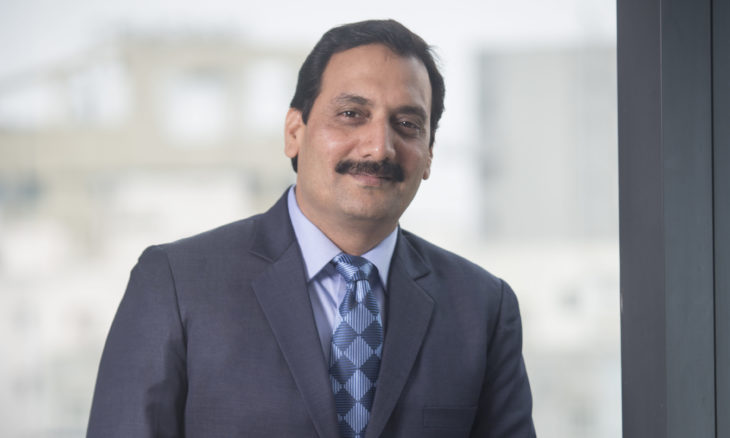
SEFL, with the total disbursement of Rs 169,895.7 million in FY’18, continues to be a dominant financer in the CME market. While discussing strategies going forward, Devendra Kumar Vyas, CEO, Srei Equipment Finance Ltd, updates on some interesting schemes and solutions for their customers at bauma Conexpo 2018…
Tell us about SREI Equipment Finance’s performance through 2017-18.
Srei Equipment Finance Ltd (SEFL), with the total disbursement of
Rs 169,895.7 million in FY’18, continues to be a dominant financer in the construction, mining and allied equipment (CME) market. Feedback Consulting reports that SEFL was a leading financier in the CME sector in India, with an approximately 33 per cent market share in FY’18.
In FY’18, the company saw a marked improvement in its financial performance. Buoyed by a rejuvenated infrastructure segment, the total Asset under Management (AUM) grew to Rs 300,727.7 million, representing a 41.6 per cent growth over last year. The Gross Non-Performing Assets (GNPA) reduced from 2.5 per cent in 2016-17 to 1.8 per cent in 2017-18, while the Net Non-Performing Assets have reduced from 1.8 per cent in 2016-17 to 1.3 per cent in 2017-18. The Capital Adequacy Ratio (CAR) remained compliant at 15.9 per cent. The profit before tax grew to Rs 394.41 crore in FY’18 from Rs 216.42 crore in 2016-17.
The improved financial performance is a result of SEFL’s continued inroads into newer asset classes and lifecycle solutions that provides customer value and investment in technology which benefits its service delivery, customer experience, and risk prognosis.
What are the USPs that have contributed in strengthening and maintaining your company’s popularity in the market?
The clear market differentiator for SEFL has been its holistic approach in providing end-to-end solutions that cover the entire value chain in the equipment life cycle that includes equipment procurement, deployment, maintenance, second life financing, and exit stages. Our partnerships with OEMs are the most distinguishing aspect of our equipment-centric business model. These include various arrangements such as general associations, preferred financier associations and private label associations. Our customer-focused approach also has contributed to our success. We cater to a wide range of customers, from ‘First Time Users’ and ‘First Time Buyers” to fleet owners and mid-size contractors to large corporations and project owners. Supported by our holistic equipment financing solutions approach, our customer-focused approach has helped us retain our customers as their business has grown in size as well as expand our customer base through their referrals.
Our years of experience in the equipment financing business have provided us with deep insight into various equipment categories, diverse geographies and multiple customer segments. Our risk assessment framework and credit appraisal policies are an outcome of this experience, which we have progressively institutionalised. As we continue to diversify our customer exposures, we are scaling up our asset-centric risk approach to cover multi-dimensional risks. We increasingly manage risk by deploying technology including real time equipment location identification through GPS/ GPRS devices, use of handheld devices by field personnel, customer service through online portals, mobile applications and customised risk prognosis tools.
What is your current outlook on the equipment finance sector in India, given the government’s thrust on infrastructure development?
The government is earnestly working towards enhancing India’s attractiveness as an investment destination. In order to sustain the growth momentum and to create jobs, the government has been proactively spending on infrastructure creation. An estimated budgetary and extra budgetary expenditure of Rs 5.97 trillion has been finalized for 2018-19 as against an estimated expenditure of Rs 4.94 trillion in 2017-18, an increase of 21 per cent. Sectors such as railways, and roads and highways, and housing and urban affairs have witnessed increased year-on-year (y-o-y) budget allocations for FY’18–‘19 by 22 per cent, 10 per cent, and 57 per cent respectively. Recently, the Indian Government has approved a total investment of Rs 6,920 billion for the construction of 83,677 km of roads in five years. These create requirement of capital goods on a large scale and increase in the number of contractors executing these projects.
Demand for infrastructure equipment is expected to multiply as a result of all these. Thus, demand for financing of such assets is also bound to rise. With GST unifying the Indian market, inter-state mobility of these assets is no longer a problem. Thus, this is the ideal time to promote cost-effective methods of utilisation of these assets like renting and leasing.
According to a report by Feedback Consulting, the construction equipment finance industry is expected to grow at a CAGR of 20-21 per cent for the next three years until Fiscal 2021. With the current announced projects which mostly have started from the third quarter of Fiscal 2018, demand will continue for the earthmoving equipment industry, which will have a share between 68-70 per cent of the overall CME finance market. Banks and NBFCs are expected to have an equal share in the CME finance industry for the next one to two years with the equipment leasing industry expected to grow at a CAGR of 15-16 per cent until Fiscal 2020.

